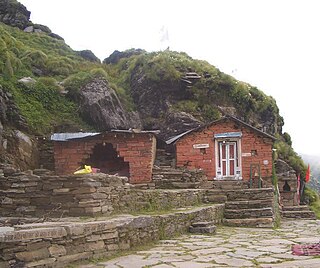
Parsis or Parsees are a Zoroastrian community who migrated to the Indian subcontinent from Persia during the Arab conquest of Persia of 636–651 AD; one of two such groups. According to the Qissa-i Sanjan, Parsis migrated from Greater Iran to Gujarat, where they were given refuge, between the 8th and 10th century AD to avoid persecution following the Muslim conquest of Persia.

Edward James Corbett was a British hunter, tracker, naturalist, and author who hunted a number of man-eating tigers and leopards in India.

The alvars, also spelt as alwars or azhwars were Tamil poet-saints of South India who espoused bhakti (devotion) to the Hindu god Vishnu or his avatar Krishna in their songs of longing, ecstasy and service. They are venerated especially in Vaishnavism, which regards Vishnu or Krishna as the Supreme Being.

Purnia district is one of the thirty-eight districts of the Indian state of Bihar. The city of Purnia is the administrative headquarters of this district. Purnia district is a part of Purnia Division. The district extends northwards from the Ganges river. Purnia is the unofficial capital of Seemanchal due to its financial and educational importance.

A Divya Desam or Vaishnava Divya Desam is one of the 108 Vishnu temples that are mentioned in the works of the Alvars (saints). ”Divya” means “premium” and “Desam” indicates “place” (temple). Of the 108 temples, 105 are in India, one is in Nepal, and last two are believed to be outside the Earthly realms. In India, they are spread over states of Tamil Nadu (85), Kerala (11), Andhra Pradesh (2), Gujarat (1), Uttar Pradesh (4), Uttarakhand (3). Muktinath, Saligramam is the only Divya Desam in Nepal. The last two are Thirupalkadal and Paramapadam. Tirupalkaddal is the ocean of milk and paramapadam is the Vaikuntha where Lord Vishnu presides. The Divya Desams are revered by the 12 Alvars in the Divya Prabandha, a collection of 4,000 Tamil verses. Divya Desams follow Thenkalai or Vadakalai modes of worship.
Bhoothath Azhwar is one of the twelve azhwar saints of South India, who are known for their affiliation to Vaishnava tradition of Hinduism. The verses of azhwars are compiled as Nalayira Divya Prabandham and the 108 temples revered are classified as Divya desam. Bhoothath is considered second in the list of the three principal azhwars, with the other two being Poigai Azhwar and Pey Azhwar, collectively called Muthalamazhwargal who are known to be born out of divinity. Bhoothath composed hundred verses that are classified as Irandam Tiruvandadhi and his composition is set in the Andhadhi style in which the ending syllable is the starting one for the next verse.
Pey Azhwar is one of the twelve azhwar saints of South India, who are known for their affiliation to Vaishnava tradition of Hinduism. The verses of azhwars are compiled as Nalayira Divya Prabandham and the 108 temples revered are classified as Divya desam. Pey Azhwar is considered third in the list of the three principal azhwars, with the other two being Poigai Azhwar and Bhoothathazhwar, collectively called Muthalamazhwargal who are known to be born out of divinity. Pey Azhwar composed hundred verses that are classified as Moondram Tiruvandadhi and his composition is set in the Andhadhi style in which the ending syllable is the starting one for the next verse.
Thirumazhisai Alvar is a Tamil saint revered in the Srivaishnavism school of south India, in Tondai Nadu. He was born in 4203 BCE. The legend of this saint devotees of Srivaishnavism believe that he was the incarnation of Vishnu's disc, Sudarshana. He is believed to have been born at Jagannatha Perumal temple, Tirumazhisai by divine grace.
Thiruppaan Alvar or Thirupaanazhwar is one of the twelve azhwar saints of South India, who are known for their affiliation to Vaishnava tradition of Hinduism. The verses of azhwars are compiled as Nalayira Divya Prabandham and the 108 temples revered are classified as Divya desam. Thirupaanazhwar is considered the eleventh in the line of the twelve azhwars.
The Alvars during the early medieval period of Tamil history worshipped Vishnu and his avatars through their hymns. This collection of their hymns is known as Divya Prabhandham. Mangalasasanam means "praying that the holy shrines be happy all the time". The Srivaishnava shrines that were sung about by the Alvars are called Divya Desams. The divyadesams that have the most number of pasurams sung upon them are Srirangam (247), Thirumala (202), Thirumaliruncholai and Thirukannapuram.

Rudranath is a Hindu temple dedicated to god Shiva, located in the Garhwal Himalayan mountains in Uttarakhand, India. Located at 3,600 metres (11,800 ft) above sea level, this natural rock temple is situated within a dense forest of rhododendron dwarfs and Alpine pastures. The temple is the third temple to be visited in the Panch Kedar pilgrimage circuit, comprising five Shiva temples in the Garhwal region. The other temples in the circuit includes: Kedarnath and Tungnath to be visited before Rudranath and Madhyamaheshwar or Madmaheshwar and Kalpeshwar to be visited after Rudranath. The face (mukha) of god Shiva is worshipped as "Nilkanth Mahadeva" here. Trek starts from Sagar village which is approx 03 km from Gopeshwar. The other trek starts from Mandal which is 12 km from Gopeshwar. This trek goes through Anusuya devi temple. Trek is very hard with a distance of approx 24 km.
Thumbolarcha is a 1974 Indian Malayalam film, directed and produced by Kunchacko. The film stars Prem Nazir, Sheela, Srividya and Thikkurissi Sukumaran Nair in the lead roles. The film has musical score and songs composed by G. Devarajan.

Tiru Nilakanta Yazhpanar was a Nayanar saint, venerated in the Hindu sect of Shaivism. He is generally counted as the sixty-first in the list of 63 Nayanars. While the first part of his name can be spelt as Tirunilakanta, Tirunilakantha, Tiru Neelakanta, Tiru Nilakanta, Nilakantan and Thiruneelakanda, Yazhpanar is spelt as variously as Yalppanar, Yalapannar, Yalpanar and Yazhpaanar. He is described as a companion of Sambandar, one of the most prominent Nayanars.

The Sarju River, also known as Saryu, is a major river draining Central Kumaon region in the Indian state of Uttarakhand. Originating from Sarmul,Sarju flows through the cities of Kapkot,Bageshwar and Seraghat before joining Mahakali at Pancheshwar. The Sarju is the largest tributary of the Sharda River. The river forms the South-eastern border between the districts of Pithoragarh and Almora. Temperate and sub-Tropical forests cover the entire Catchment area of the River.
National Highway 309B, commonly referred to as NH 309B is a national highway in India. It is a spur road of National Highway 9. NH-309B traverses the state of Uttarakhand in India.






